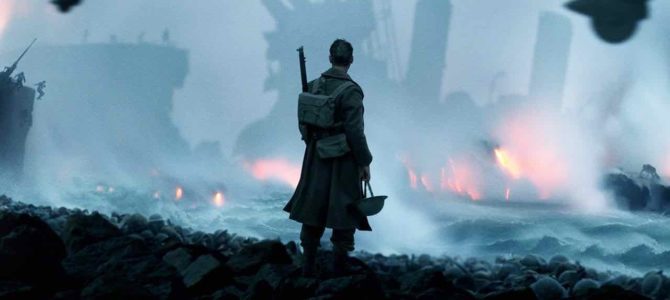
Recently, I watched “Dunkirk” and “Darkest Hour,” or as I now call it, “Dunkirk: The Indoor Story,” starring Gary Oldman. The two feature films, each with their own Oscar buzz, cover the same cataclysmic rout and retreat from France as Hitler advanced across Western Europe almost without vulnerability in 1940.
Because they are set in the same historic event, the two films inevitably invite comparison, as in SlashFilm’s “Dunkirk vs. Darkest Hour: How Christopher Nolan succeeds where Joe Wright Fails.” The verdict is shared by many film critics, despite an engaging performance by Oldman as Churchill:
Part of the problem has little to do with Darkest Hour, and everything to do with Dunkirk. In a year with Christopher Nolan’s stripped-down exercise in tension, a film that sidesteps so many of the trappings of the period drama and the wartime epic, another movie covering the same subject matter even in a different light is bound to fall short. … Where Dunkirk felt like it was breaking ground, Darkest Hour feels like it’s following a well-worn, overly familiar path.
I’d also choose “Dunkirk” as my favorite of the two, but in this day and age of streaming, one doesn’t have to choose, and one shouldn’t. Even casual movie and history fans would benefit from seeing both films. They’re both beautiful and beautifully complementary.
What struck me more than anything about them is how they’re diametrically different tellings of the same time period, almost as if they were designed to be as different from one another as possible. “Dunkirk” is about the men on the ground; “Darkest Hour,” the men at the top. “Dunkirk” is non-linear and in “Darkest Hour,” Wright is so linear, he marks time with a full-screen antique desk calendar rolling heavily through the days. “Dunkirk” is all big vistas, but ultimately a very confined picture of the war. “Darkest Hour” is all claustrophobic settings paired with a much bigger window on the conflict.
The result is each film’s perceived deficiencies are largely answered by the other film. Those with complaints about “Dunkirk” call it, as one film history professor said to me on Twitter, “loud and empty.” We don’t know much about the characters or even the desperation of their situation outside of a title card with some minimal historic context. Unless you know a bit from history class about how important and impossible it was to get those men off that beach, I think it’s fair to say you might miss some of that in “Dunkirk.” Others found the tryptic storytelling — Nolan splits the evacuation into action by land, sea, and air — needlessly complicated and confusing.
I found “Dunkirk” visceral and the timeline a bit challenging, but it paid off nicely as the movie’s three storylines join as the action culminates. The brutality of the war amid the beauty of the French and English coasts in “Dunkirk’s” sweeping cinematography felt like an apt metaphor for the devastating battles being waged in the Continent’s quaint and gorgeous settings, with the movies very last scene a perfect, tragic meeting of the two. I felt instantly connected to the characters despite the lack of almost any dialogue or names (and in the case of the pilots played by Tom Hardy and Jack Lowden, even their faces are covered for most of the movie).
But I can understand the concerns, and if you think you’d have those concerns, have I got a movie for you to watch before you watch “Dunkirk.”
“Darkest Hour” is as relentlessly linear as Nolan’s film is non-linear. Wright, who directed 2007’s “Atonement,” makes the absolute most of his grim, British, often underground settings, allowing sparse shafts of light and a sepia tone to feel very much like an ancient text book come to life. If you’re new to the history of this era, “Darkest Hour,” despite some of the liberties it takes with the record, is probably a more useful film for getting an understanding of what happened. It has the feel of an extremely high-end docudrama of the era, with warm and fully realized characters guiding the way.
Despite its dark settings, “Darkest Hour” also gives viewers hope more often than “Dunkirk.” Centered on Churchill’s three important speeches of the era, the viewer can’t help but be lifted by his words. “Darkest Hour” is about the ability to marshal ideas to martial effect in times of crisis, and just as he did then, Oldman’s Churchill does so masterfully. The hopelessness of “Dunkirk” becomes less hopeless on the other side of the Channel in the hands of a leader, just as it needed to for the people of England in 1940.
After having seen both, the ideal way to do it would be to watch “Darkest Hour” and then “Dunkirk,” on a big screen if you can find it. Wright’s film loses less than Nolan’s in at-home viewing.
In the end, “Darkest Hour” tells the story of the near destruction of Western Civilization. “Dunkirk” allows you to feel it in all its uncomfortable, confusing horror. You’ll remember “Dunkirk,” but if you watch “Darkest Hour,” the moment in history and the people who defined it will stick with you, too.









